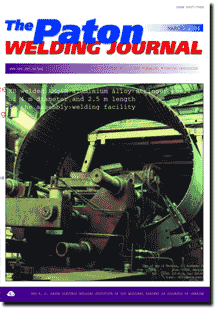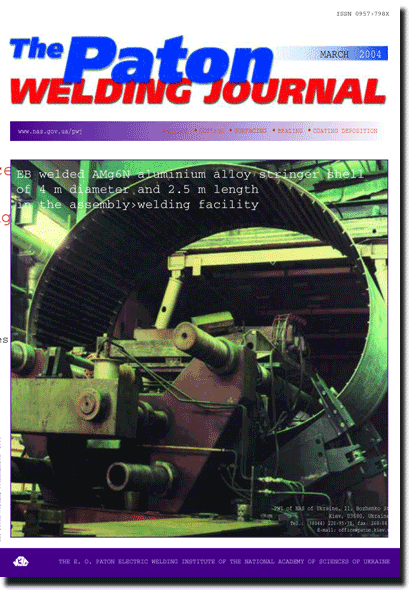

| SCIENTIFIC AND TECHNICAL | |
| Skulsky V.Yu. and Tsaryuk A.K. Problems of selection of weldable steel for high-temperature components of TPS power units (Review). | 2 |
| The paper deals with the features of technical "re-equipment" of power units of thermal power stations over the last 20 years. Advances in this field were made possible by development and application of new complex-alloyed heat-resistant steels with a higher chromium content. Alloying influence on phase composition, corrosion resistance, ageing processes, long-term strength and weldability of new high-chromium heat-resistant steels has been analyzed. | |
| Grigorenko G.M., Golovko V.V., Grabin V.F. and Kostin V.A. Effect of metallurgical characteristics of flux on structure and phase composition of high-strength weld metal. | 7 |
| It was established that reduction in oxygen potential of a welding flux promotes a change in the content of alloying elements in acicular ferrite and decrease in size of inclusions forming in low-alloy high-strength weld metal. In use of fluxes with a low oxygen potential the integrated deoxidation by aluminium and titanium leads to the decrease in molybdenum content in the acicular ferrite and increase in the brittle fracture resistance of the weld metal. | |
| Kulik V.M., Savitsky M.M., Novikova D.P. and Krasnoshchekova V.A. Features of argon-arc treatment with insipient melting of welded joint on quenching steel. | 15 |
| It is shown that treatment of welded joints on 30KhGSA steel improves weld metal formation, refines its structure, produces higher impact toughness of the HAZ metal of welded joint. It is established that in argon-arc treatment of a welded joint on medium-carbon alloyed steel MAC-phase precipitates can form in the HAZ overheated region. | |
| Kabatsky V.I. and Kabatsky A.V. Effect of modifying of weld metal on delayed fracture resistance of high-strength steel welded joints. | 21 |
| It is shown that at a complex modifying of 10KhGNM type weld metal with nitrogen and vanadium, in combination with cerium, it is possible to obtain the most stable resistance of welded joints, made from martensitic steel 33KhSN2MA, against the cold cracking. This promotes the favourable change in structure and morphology of non-metallic inclusions in metal of the fusion zone of joints. | |
| Kovalchuk V.S. Allowance for effect of cycle asymmetry on crack resistance of steels and welded joints at two-frequency loading | 26 |
| It was established that increase in a coefficient of cycle asymmetry from R = 0 up to R = 0.5 at two-frequency loading leads to 3-4 times increase in propagation rate of fatigue cracks in parent metal and up to 2 times increase in weld metal of butt welded joints of high strength (sy ~ 1000 MPa) steel. Calculation method is offered allowing determination of a cyclic crack resistance of structural materials and welded joints under the conditions of a two-frequency loading using the fatigue fracture diagrams corresponding to a single-frequency loading with an appropriate coefficient of a cycle asymmetry. | |
| INDUSTRIAL | |
| Blashchuk V.E. Titanium: Alloys, welding, application | 30 |
| Advantages of titanium and its alloys compared with currently available traditional materials are shown. Processes for producing commercial titanium and titanium alloys, as well as processes for their welding and welding consumables, are described. The most promising cases of application of titanium and its alloys are noted. | |
| Kononenko V.Ya. PWI developments in the field of underwater welding and cutting. | 38 |
| Generalizing information is given on a number of design developments in the field of underwater welding and cutting, performed at the E.O. Paton Electric Welding Institute since 1966. An attempt has been made to evaluate them from the user's viewpoint. | |
| Leskov G.I. and Pustovojt S.V. Device for fixation of oscillations of the weld pool. | 44 |
| One of the factors that increase penetrating power of the pulsed arc is making the current pulse frequency match the frequency of natural free oscillations of the weld pool. Device that allows fixation of amplitude and period of oscillations of the metal melt during welding has been made to find conditions for "resonance" to be established between the disturbing force and natural oscillations of the weld pool. | |
| BRIEF INFORMATION | |
| Maksimov S.Yu. Underwater wet welding of 17G1S steel with preliminary explosion treatment of edges. | 47 |
| The effect of a charge type of explosives and method of their application at preliminary shock-wave treatment of edges welded on the parameters of HAZ of 17G1S steel joints, made under the water, were investigated. The feasibility of significant refining of grains in HAZ area, decrease in its width, localization of lineage non-metallic inclusions was established. Application of preliminary explosion treatment of edges allows reducing the risk of cold cracking in the HAZ metal. | |
(You are viewing the simplified file contents)
Sorry, the PDF of this issue is not yet available
The cost of subscription/purchase order journals or individual articles
| Journal/Currency | Annual Set | 1 issue printed |
1 issue |
one article |
| TPWJ/USD | 384 $ | 32 $ | 26 $ | 13 $ |
| TPWJ/EUR | 348 € | 29 € | 24 € | 12 € |
| TPWJ/UAH | 7200 UAH | 600 UAH | 600 UAH | 280 UAH |
| AS/UAH | 1800 UAH | 300 UAH | 300 UAH | 150 UAH |
| AS/USD | 192 $ | 32 $ | 26 $ | 13 $ |
| AS/EUR | 180 € | 30 € | 25 € | 12 € |
| SEM/UAH | 1200 UAH | 300 UAH | 300 UAH | 150 UAH |
| SEM/USD | 128 $ | 32 $ | 26 $ | 13 $ |
| SEM/EUR | 120 € | 30 € | 25 € | 12 € |
| TDNK/UAH | 1200 UAH | 300 UAH | 300 UAH | 150 UAH |
| TDNK/USD | 128 $ | 32 $ | 26 $ | 13 $ |
| TDNK/EUR | 120 € | 30 € | 25 € | 15 € |
AS = «Automatic Welding» - 6 issues per year;
TPWJ = «PATON WELDING JOURNAL» - 12 issues per year;
SEM = «Electrometallurgy Today» - 4 issues per year;
TDNK = «Technical Diagnostics and Non-Destructive Testing» - 4 issues per year.


